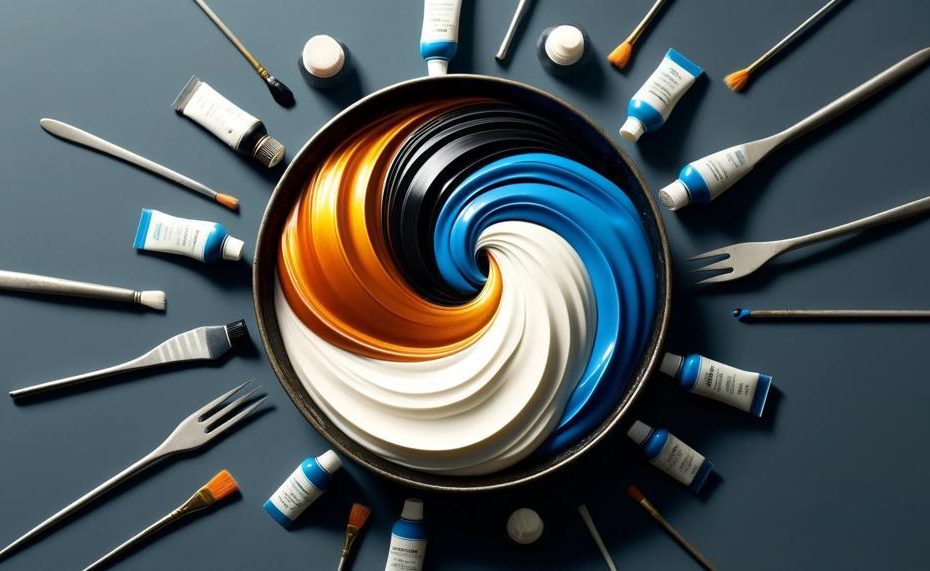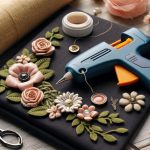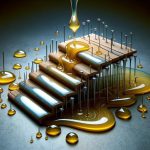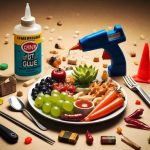Did you know that integrating glue into paint can profoundly alter its characteristics, enhancing both its texture and adhesive properties? This innovative method is not just a crafters’ secret but is increasingly used by professionals to achieve unique finishes and durable coats in various artistic and architectural projects.
So, can i mix glue with paint?
Yes, you can mix glue with paint. This technique is often used in various art forms, including acrylic pour painting1. Here are some steps to guide you through the process:
- Prepare a mixture of glue and water: Start with a 50/50 mixture of glue and water in a container.
- Mix paint and glue-water mixture: Pour some acrylic paint of your choice into another container and add the same amount of glue and water mixture.
- Stir until smooth: Stir well until the paint has a smooth consistency that forms a small puddle on the surface when dripped from a stick.
- Add silicone oil (optional): If you want to create cells in your pour painting, add a few drops of silicone oil and lightly mix it.
- Transfer to a squeeze bottle: Transfer the paint into a squeeze bottle for easy pouring.
Remember, the type of glue and paint being used influences the outcome. Mixing glue with paint may alter the drying time and finish of the paint. The addition of glue can extend the drying time, so it is essential to allow sufficient time for the artwork to dry completely before handling or applying additional layers.
This blend technique, while offering enhanced properties, may also impact the paint’s longevity and archival quality. It’s essential to choose the right type of glue based on the project’s requirements and the materials involved.
As we delve deeper into this topic, we’ll explore the science behind this fusion, share expert tips on achieving the best results, and discuss how to avoid common pitfalls.
Get ready to transform your next project with a simple yet effective twist in your paint application.
Table of Contents [show]
What is Glue and Paint?
Glue and paint, though used in similar contexts like crafting and building, have distinct functions and chemical properties. Glue is an adhesive substance used to bind materials together. It is characterized by its viscosity, drying time, and bonding strength, which can vary widely depending on the type.
Paint, on the other hand, is a coloured substance applied to surfaces to colour, protect, or provide texture. It typically consists of pigments suspended in a liquid binder, such as oil or latex.
When these two materials are mixed, they interact based on their chemical and physical properties. The key factors in their interaction include compatibility, the correct ratio of mixture, and the specific types of glue and paint used.
For instance, polyvinyl acetate (PVA) glue blends well with latex-based paints, enhancing the paint’s thickness and improving adhesion on porous surfaces. Conversely, combining glue with oil-based paint requires careful selection, like using epoxy resins to maintain the integrity of the bond.
Here’s a concise breakdown of how glue and paint can work together:
| Type of Paint | Type of Glue | Effect of Mixture |
| Latex Paint | PVA Glue | Improves adhesion and thickness for better coverage on porous materials. |
| Oil-based Paint | Epoxy Resin | Enhances durability and bonding strength, suitable for tougher surfaces. |
| Acrylic Paint | Mod Podge or Gel Medium | Adds texture and depth, useful for artistic effects and enhancements. |
Mixing glue with paint requires a good understanding of both materials to ensure the desired outcome.
The ratio and method of mixing are crucial; too much glue can lead to a brittle, peeling finish, while too little may not significantly impact the paint’s properties.
What Happens When You Mix Glue with Paint?
Mixing glue with paint can transform the properties of the paint, impacting its consistency, texture, and finish. Here’s how these changes manifest:
- Consistency and Texture: Adding glue to paint typically thickens the mixture, lending it a more viscous consistency. This thickening can facilitate better application on surfaces where regular paint might run or drip. For artistic projects, this combination can add a dimensional, textured look that might appear somewhat three-dimensional when dry.
- Finish: The type of finish achieved by mixing glue with paint can vary. Typically, the addition of white school glue to acrylic paint results in a slightly matte finish due to the glue’s inherent characteristics. However, the final sheen is influenced by the type and amount of glue used. Using clear-drying glues can help maintain the paint’s original luster to a greater extent.
- Adhesion and Flexibility: Glue enhances the paint’s adhesive qualities, making it stick better to challenging surfaces like glass or plastic. However, it’s crucial to note that while this can be beneficial for craft projects or temporary applications, the added glue may compromise the paint’s flexibility and durability, potentially leading to issues like cracking or peeling in long-term or professional applications.
- Compatibility and Precautions: Not all glues are compatible with all types of paint. For example, oil-based paints will not mix well with water-based glues like PVA (white school glue). Therefore, it’s essential to choose compatible types of glue and paint to avoid undesirable results like uneven texture or impaired drying.
Here is a table summarizing the effects of mixing glue with different types of paint:
| Type of Paint | Compatibility with Glue | Expected Finish |
| Acrylic Paint | Compatible with PVA and acrylic mediums | Matte to slightly glossy depending on glue type |
| Oil-Based Paint | Not compatible with water-based glues | N/A |
| Watercolors, Tempera, Gouache | Varies; test before use | Depends on glue transparency and drying characteristics |
To ensure optimal results, always start with a small test batch to check the mixture’s behavior and effect before applying it to the final project.
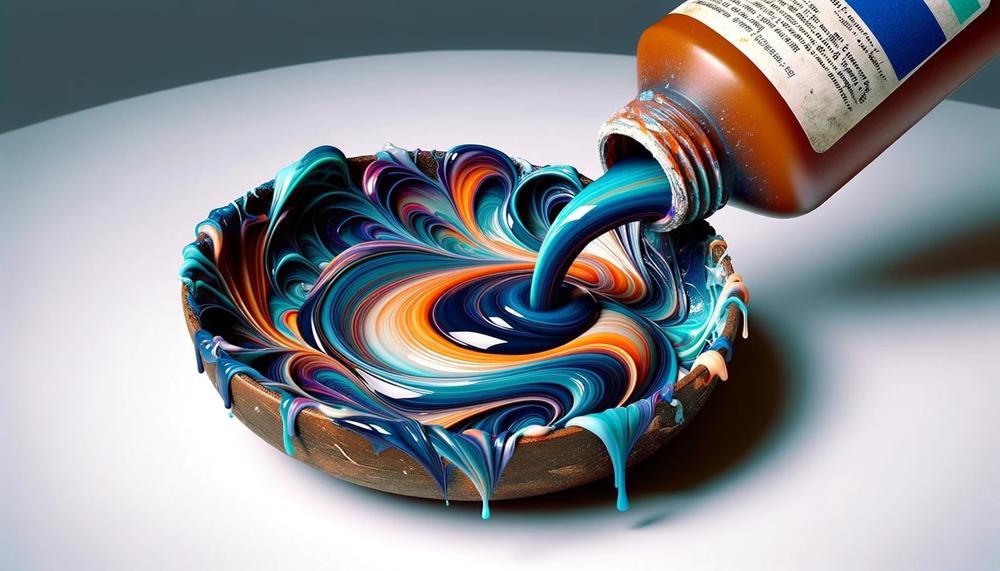
Considerations for Mixing Glue and Paint
| Factors to Consider | Impact | Solutions |
| Type and Amount of Glue Used | Determines the texture, consistency, and adhesion of the mixture. | Choose an appropriate glue that is compatible with the specific type of paint being used. |
| Potential Yellowing Effects | Can change the color of the mixture over time. | Use a clear or non-yellowing glue, or opt for a different adhesive altogether. |
| Extended Drying Time | The addition of glue may increase the drying time of the mixture. | Allow for extra drying time or add a drying agent to speed up the process. |
| Texture and Consistency Changes | Mixing glue with paint can create a thicker, more textured finish. | Adjust the ratio of glue to paint to achieve desired results. |
| Color Changes | The color of the paint may be altered by mixing it with glue. | Choose compatible glue and test the mixture before applying it to a final project. |
| Compatibility between Glue and Paint | The glue and paint must be compatible in order to achieve desired results. | Research and test different types of glues to find the best option for mixing with your specific type of paint. |
| Different Types of Suitable Glues for Mixing with Paint | Certain types of glues may work better than others when mixed with paint. | Research and test various types of glues to find the best option for your specific project. |
| Effects of Adding Glue to Paint | Mixing glue with paint can have various effects on the final product. | Test the mixture before using it on a final project to ensure desired results. |
| Testing the Mixture Before Application | It is important to test the glue and paint mixture before applying it to a final project. | Conduct a small test on a separate surface to ensure desired results before using the mixture on a final project. |
| Potential Impact on Archival Quality | The addition of glue to paint may affect the archival quality of the final product. | Consider using archival-quality glue and conduct thorough testing before using the mixture on a final project. |
Different Types of Glue Suitable for Mixing with Paint
| Type of Glue | Properties | Best Uses |
|---|---|---|
| PVA Glue | Water-soluble, dries clear | General artwork, school projects, light textures on canvas |
| Mod Podge | Water-based sealer, glue, and finish | Decoupage, collage art, layering textures |
| Gel Medium | Thick, translucent, retains brush strokes | Impasto techniques, heavy textures |
| Acrylic Retarder | Slows drying time, improves flow | Blending colors, smooth finishes in painting |
| Crafting Glue | Strong bond, dries clear or opaque depending on type | Decorative crafts, mixed media, heavy materials like glass or metal |
Each of these glues has its own unique characteristics and benefits, making them suitable for various artistic applications. PVA glue is particularly versatile for general art applications due to its flexibility and clear drying.
Mod Podge is excellent for projects that require a protective finish in addition to adhesion. Gel Medium is ideal for artists who want to build texture and volume in their paintings.
Acrylic Retarder is perfect for those looking to achieve more time blending and working with their paints, whereas Crafting Glue is great for more heavy-duty applications involving mixed media.
Effects of Adding Glue to Paint
When integrating glue into paint, the outcomes and effects on the paint’s quality and durability vary widely based on the type of both substances. Below is a detailed analysis of the potential consequences and impacts:
- Texture and Application: Glue can introduce unique textures to paint, contributing to raised or 3D effects that are particularly valued in decorative arts. However, these additives can also alter the paint’s ability to blend smoothly on surfaces, affecting its traditional application.
- Adhesion: One of the beneficial aspects of adding glue is improved adhesion on non-porous surfaces such as glass or plastic, expanding the usability of the paint. This means that projects that would typically repel paint might accept it more readily when mixed with the right type of glue.
- Durability and Flexibility: While glue can enhance the paint’s grip on certain surfaces, its influence on the paint’s durability is dual-sided. In some cases, it might increase flexibility, preventing cracking, but excessive glue can lead to a brittle finish that deteriorates quickly.
- Aesthetic Impact: Mixing glue with paint often affects its visual appeal. For instance, glue can dull the paint’s color intensity and might lead to yellowing or cloudiness over time if not acid-free.
Practical Recommendations and Considerations:
Here’s a tabulated guide to help determine when and how to integrate glue with paint, considering various aspects like project type, expected longevity, and aesthetic needs:
| Aspect | Benefit | Consideration |
| Texture | Enhances 3D effects | May hinder smooth layering |
| Adhesion | Improves stickiness on tricky surfaces | Not ideal for traditional canvas painting |
| Durability | Can prevent paint from flaking off | Potential for quicker degradation |
| Visual Quality | Potential for creative effects | Can reduce color clarity and brightness |
Before deciding to mix glue with paint, always consider the specific requirements of your project. While it’s recommended for experimental art or crafts, for professional-grade applications where longevity and predictable behavior are paramount, sticking to traditional mediums without additives like glue is advisable.
Testing the Mixture Before Application
Testing your glue and paint concoction is a wise step to ensure your project’s success, guaranteeing the mix adheres well without causing unwanted textures or colours. Here’s how you can meticulously test the mixture:
- Preparation: Begin by selecting a small, inconspicuous area or a spare piece of material similar to your project surface. This test patch should mimic the actual project area to provide accurate results.
- Mixing: Combine the glue and paint in a separate container. Follow the recommended ratios, which typically start at a 1:1 ratio for basic tests. Stir them thoroughly to achieve a uniform consistency, ensuring no streaks or lumps remain.
- Application: Apply a small amount of the mixed product to your test area. Use the same tools and techniques planned for the actual application to simulate the final look.
- Drying and Observing: Allow the test patch to dry completely. The drying time may vary depending on the glue and paint types used, as well as environmental conditions such as humidity and temperature.
- Evaluation: After the mixture has dried, assess the texture, colour, adhesion, and overall appearance. Check for any signs of peeling, cracking, or undesirable changes in hue or gloss.
- Adjustments: If the initial results are not satisfactory, adjust the ratios or try different types of glue or paint. It’s beneficial to repeat the test until achieving the desired outcome.
Potential Impact on Archival Quality
Mixing glue with paint can significantly affect the archival quality of artwork. When archival glue is blended into paint, it can alter the paint’s properties and longevity. Below are some specific impacts explained in detail:
- Chemical Stability: Archival glues are designed to be acid-free and pH-neutral, which is crucial in preventing the degradation of delicate materials over time. When mixed with paint, these glues help maintain the chemical stability of the artwork, reducing the risk of discoloration and chemical breakdown.
- Physical Integrity: Archival glues do not become brittle or yellow, characteristics that contribute to maintaining the physical integrity of the artwork. This ensures that the artwork remains in its intended form longer, without the typical aging seen with non-archival adhesives.
- Longevity: The combination of archival quality glue with paint potentially increases the longevity of the artwork. Since archival glues are formulated to last decades, their inclusion in paint mixtures can extend the life of the art beyond that achievable with traditional adhesives.
Here’s a breakdown of how different types of archival glue affect the paint’s archival quality:
| Type of Glue | Impact on Paint’s Archival Quality | Common Uses |
| PVA (Polyvinyl Acetate) | Increases flexibility and reduces yellowing over time. | Used in painting and bookbinding. |
| Methylcellulose | Enhances film strength without affecting colour stability. | Often used in paper conservation. |
| Acid-Free Glue | Prevents chemical degradation of paint components. | Common in archival framing and mounting. |
However, it is crucial to apply these mixtures correctly and sparingly. Overuse or improper application can lead to undesirable textural changes and might compromise the adhesive’s effectiveness, leading to potential warping or damage to the artwork.
Conclusion
When you mix glue and paint, you can do a lot of different kinds of art. You can turn everyday things into creative tools. As we talked about in detail, mixing these two things together changes more than just their physical qualities; it also changes the limits of what is possible in art. It’s important to choose the right glue, like Mod Podge or PVA, to get the effect you want. Glue can improve the paint’s texture and stickiness, giving it a rich, tactile finish that lasts.
Mixing different kinds of glue with different kinds of paint allows artists and makers to tailor their materials to the needs of a project. Whether you want to add more thickness for a dramatic impasto effect or secure a collage with a shiny finish, glue and paint work well together to meet both practical and aesthetic needs. But this kind of chemistry needs careful testing. Choosing ingredients that work well together and getting the right amounts is key to a successful application. This maintains the paint’s brightness and effectiveness.
Think about the specifics of your products before you use glue on your next job, consider the specifics of your products. Make sure the mixture works the way you want it to, so that your artistic idea stays true.

